Home Decor
10 Creative Ideas for Repurposed Planters
Magically transform discarded items into unique planters that showcase your personal style and add whimsy to your outdoor or indoor space.
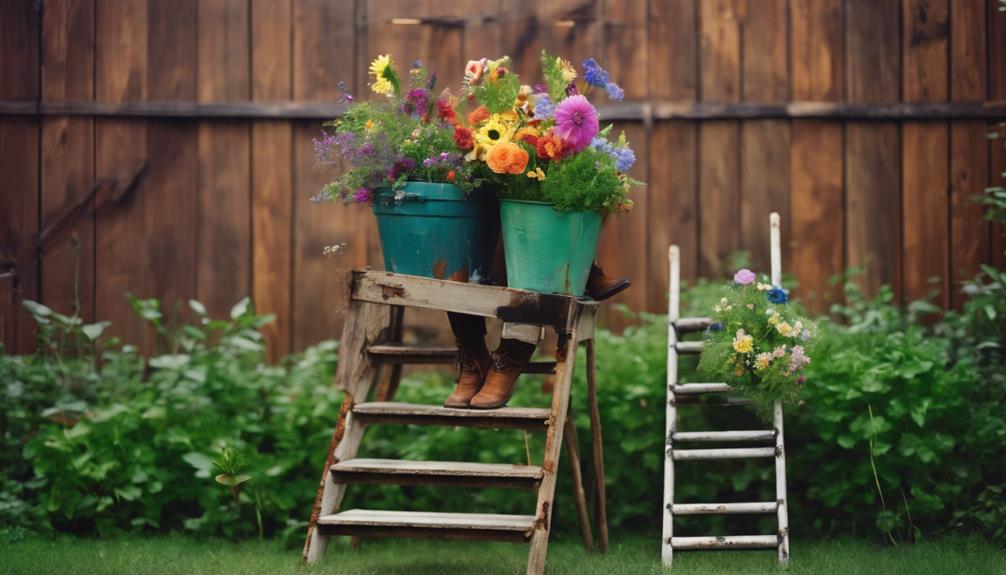
You can breathe new life into old items by repurposing them as quirky planters. Transform boots, wine bottles, and toolboxes into charming planters that add personality to your garden or indoor spaces. Upcycle vintage items, like wheelbarrows and galvanized tubs, for a unique touch. Get creative with hanging planters made from colanders, baseball hats, and jeans. Even old fabrics like jeans can be repurposed into planters. With a little imagination, you can turn trash into treasure and showcase your personal style in your outdoor or indoor space. And that's just the beginning – there are even more innovative ideas waiting to be discovered.
Key Takeaways
• Transform old boots, wine bottles, and toolbox into quirky planters that add personality to gardens and reduce waste.
• Mix and match galvanized planters for visually appealing arrangements that add rustic charm to outdoor spaces.
• Upcycle old fabrics like jeans into hanging planters that add a whimsical touch to gardens and indoor spaces.
• Add personal touches to planters with embroidery or appliques to showcase creativity and personality in outdoor spaces.
• Repurpose vintage items like wheelbarrows and crates into unique planters that add enchantment and elegance to gardens and patios.
Boot Up Your Garden Style
Transform your old boots into quirky planters that add a pop of color and personality to your garden, and give your outdoor space a unique style that reflects your green thumb.
By repurposing old boots as planters, you're not only reducing waste but also adding a whimsical touch to your garden decor. Brightly colored rain boots, for instance, can match your garden's color scheme while showcasing your favorite plants. This sustainable approach to gardening is a great way to reuse old footwear and add visual appeal to your outdoor space.
You can fill your repurposed boot planters with flowers, herbs, or succulents, depending on your personal style and the overall aesthetic you want to achieve. With a little creativity, old boots can be transformed into charming planters, making them a fun and creative way to introduce greenery and personality to your garden.
Turning Trash Into Treasure
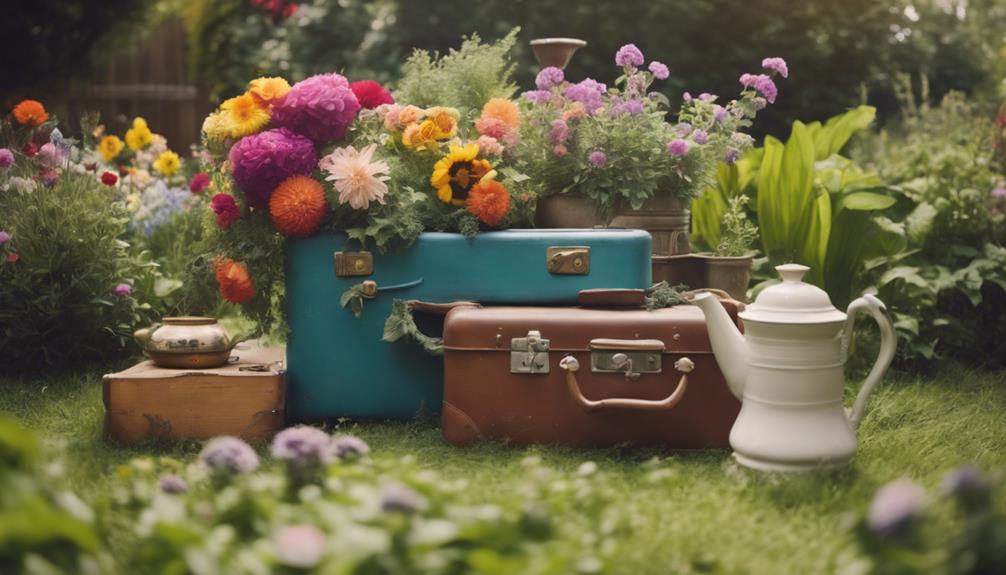
By repurposing discarded items as planters, you'll not only reduce waste but also infuse your garden with a touch of personality and whimsy. This creative approach to gardening is all about turning trash into treasure, giving new life to items that would otherwise end up in landfills.
A repurposed garden isn't only eco-friendly but also offers a unique way to express your personal style. With a little creativity, you can transform everyday objects into charming planters that add character to your outdoor space.
Think beyond traditional planters and explore the possibilities of upcycled materials. Old boots, wooden crates, and even plastic bottles can be transformed into functional and visually appealing plant containers.
Whimsical Wine Bottle Planters
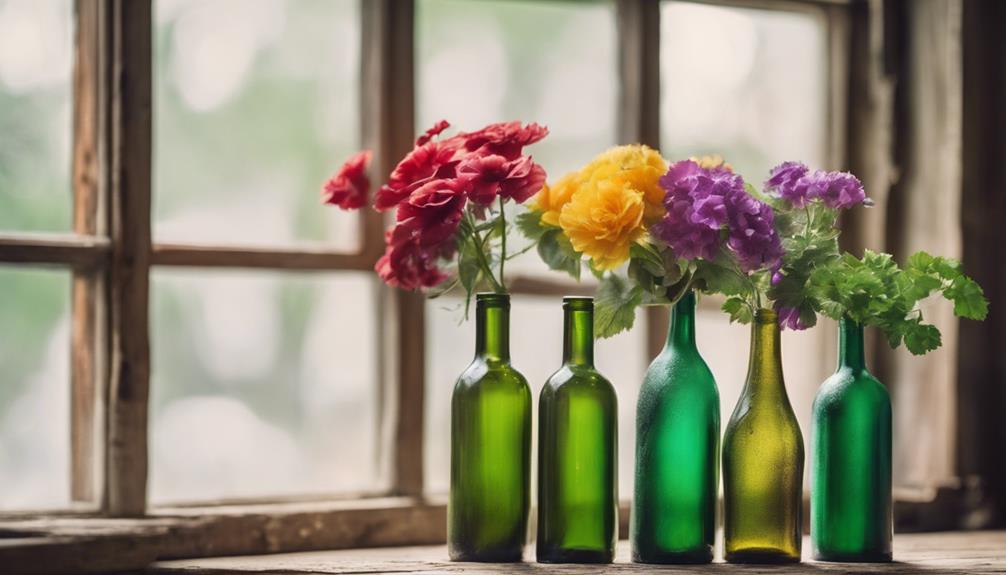
As you explore the world of whimsical wine bottle planters, you'll discover that the key to creating unique and eye-catching containers lies in the details.
You'll need to select the perfect wine bottle, add a personal touch with paint and decorations, and finish it off with a rustic flair using twine and ribbon embellishments.
Wine Bottle Selection
You can turn your favorite wine bottles into charming planters that add a touch of personality to your garden or indoor space. By upcycling wine bottles, you'll not only reduce waste but also create a unique container for your plants.
When selecting wine bottles for repurposing, consider the following:
- Bottle shape and size: Look for bottles with interesting shapes or unique labels that will add visual appeal to your planter.
- Material: Opt for bottles made from eco-friendly materials or those with a unique texture that will add character to your planter.
- Color: Choose bottles with a color that complements your outdoor or indoor decor, or those that will provide a pop of color to your space.
Painting and Decorating
Reveal your creativity and turn your wine bottle planters into one-of-a-kind pieces of art by expressing your imagination with paint and decorations.
As you design your repurposed planter, remember that the possibilities are endless. You can paint your wine bottle planters in vibrant colors or patterns to enhance their visual appeal.
For a more personalized touch, decorate your planters with designs such as flowers, patterns, or labels that reflect your personal style.
Upcycling wine bottles into planters isn't only budget-friendly and eco-friendly but also allows you to add a touch of creativity to your garden or indoor space.
By painting and decorating your wine bottle planters, you can create unique pieces that showcase your artistic side.
Whether you're a seasoned artist or a DIY enthusiast, the process of transforming a discarded wine bottle into a beautiful repurposed planter is both fun and rewarding.
Twine and Ribbon Embellishments
Wrap twine or ribbon around your repurposed wine bottle planter to infuse a touch of whimsy, creating a charming, eclectic look that adds character to your garden or indoor space. This simple yet effective embellishment can elevate your container gardens, making them stand out from the ordinary.
With twine and ribbon available in a wide range of colors and textures, you can easily match them to your planter's style and theme.
Here are some benefits of using twine and ribbon embellishments:
- Easy to apply: Simply wrap the twine or ribbon around the bottle neck or body, securing it with glue or a knot.
- Versatile: Choose from a variety of colors and textures to match your planter's style and theme.
- Adds character: Twine and ribbon embellishments can add a touch of personality to your repurposed wine bottle planters, making them truly unique.
Toolbox Blooms and Beauty
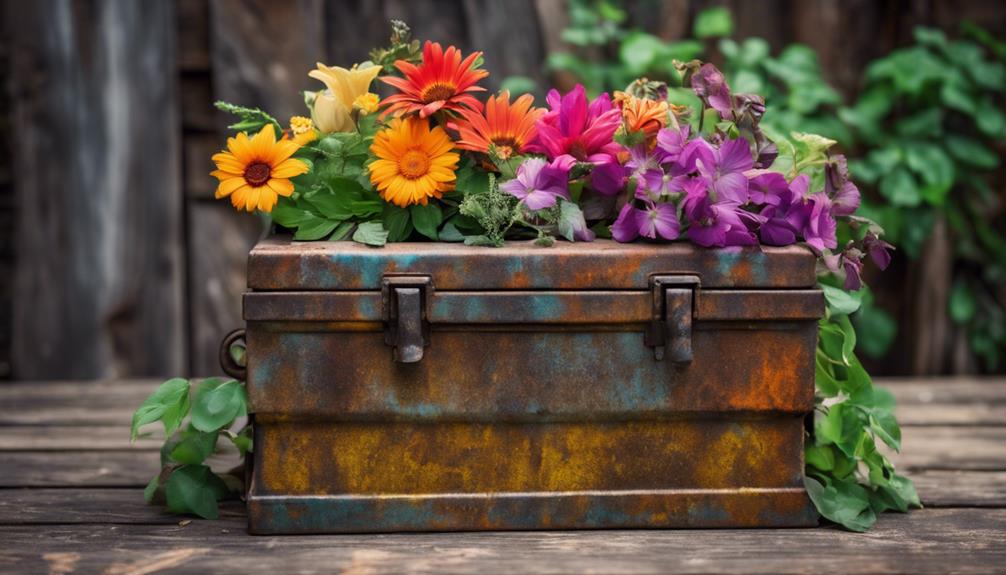
As you explore the world of toolbox planters, you'll want to take into account a few essential factors to make sure your blooms thrive. First, you'll need to arrange your toolbox planter to maximize space and accessibility, which is where our toolbox organization tips come in handy.
Next, selecting the right plants for your toolbox planter is essential, and we'll guide you through the process with our expert advice on toolbox plant selection.
Toolbox Organization Tips
You can breathe new life into an old toolbox by converting it into a planter that not only adds a touch of vintage charm to your garden but also helps you get creative with your storage. By repurposing an old toolbox, you're not only giving new life to a discarded item but also creating a unique planter that adds character to your outdoor space.
To guarantee your toolbox planter remains organized and functional, here are a few tips to keep in mind:
- Clean and prepare the toolbox: Before adding soil and plants, make sure to clean the toolbox thoroughly and add a layer of pebbles or rocks for proper drainage.
- Choose the right plants: Select low-maintenance plants like succulents that thrive in containers with built-in drainage.
- Add a personal touch: Consider adding a coat of paint or decorative hardware to give your toolbox planter a personalized look.
Toolbox Plant Selection
With a few carefully selected blooms, your toolbox planter can burst with vibrant color and charming appeal. As you choose your flowers, consider low-maintenance options that thrive in well-draining soil, which is essential for preventing wood rot in your repurposed toolbox.
Succulents, herbs, and flowering annuals like petunias or pansies are great choices, as they require minimal watering and care. These plants won't only add a pop of color to your outdoor space but also create a stunning visual contrast against the rustic toolbox. By selecting plants that complement the weathered charm of your toolbox, you'll create a unique and engaging display that showcases your creativity and flair for upcycling.
Toolbox Drainage Hacks
Your toolbox planter's drainage system is crucial to preventing waterlogged soil and wood rot, so make sure to drill holes in the bottom of the box to create a well-functioning drainage system. This simple step will guarantee that your plants thrive and your toolbox remains in great condition. By allowing excess water to escape, you'll prevent water from accumulating in the soil and causing damage to the wood.
To take your toolbox drainage to the next level, consider these hacks:
- Add a layer of small rocks or pebbles at the bottom of the toolbox to improve drainage and prevent soil from washing away.
- Line the toolbox with a breathable material, such as landscape fabric or coconut coir, to help excess water escape and prevent it from accumulating in the soil.
- Elevate the toolbox by placing it on blocks or feet to improve airflow and allow water to drain more easily.
Vintage Chic in the Garden
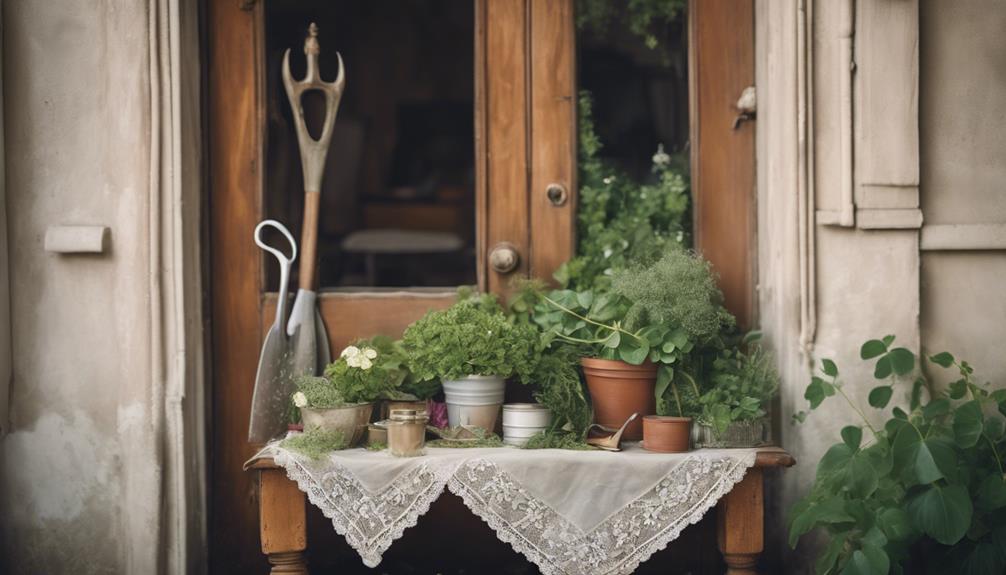
Embracing the charm of bygone eras, vintage items can be transformed into one-of-a-kind planters that infuse your garden with a nostalgic ambiance. You can repurpose antique toolboxes, chicken feeders, and farmhouse sinks into unique plant containers that add character to your outdoor space. These salvaged items not only reduce waste but also bring a touch of history to your garden design.
| Vintage Item | Planter Idea |
|---|---|
| Old Boots | Plant a small succulent or herb in each boot for a whimsical display |
| Whiskey Barrels | Transform into a self-watering planter for a lush herb garden |
| Metal Antiques | Use as a statement piece for a small shrub or flower arrangement |
| Coffee Mugs | Create a mini garden in each mug for a charming centerpiece |
Galvanized Glamour Planters
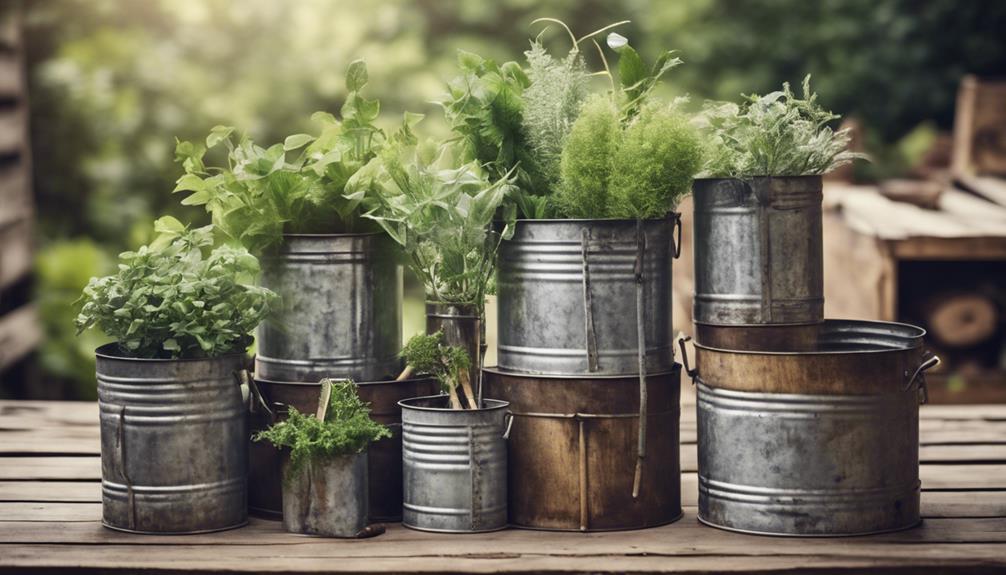
Galvanized planters, with their distressed, vintage charm, can add a touch of rustic sophistication to your outdoor space, perfect for those seeking a more laid-back, country-inspired garden style. These planters aren't only visually appealing but also durable and long-lasting, making them an ideal choice for both cottage and modern gardens.
Whether you're looking to create a whimsical or elegant atmosphere, galvanized planters can adapt to your style.
To elevate your garden's aesthetic, consider the following ideas:
- Mix and match: Combine galvanized planters of varying sizes and shapes to create a visually appealing arrangement.
- Add a pop of color: Incorporate brightly colored flowers or greenery to contrast with the planters' rustic charm.
- Get creative with containers: Repurpose old wheelbarrows or galvanized tubs as planters to add a unique touch to your garden.
Wheelbarrow Wonders Unveiled
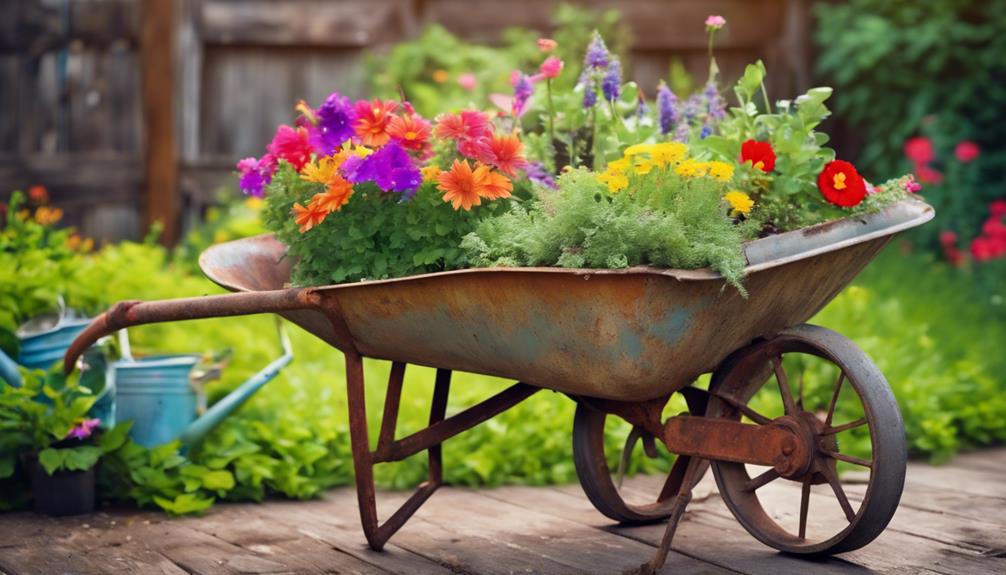
As you explore the world of repurposed planters, you'll discover that wheelbarrows can be transformed into charming garden features that add a touch of enchantment to your outdoor space.
By restoring vintage charm and incorporating them into your garden decor, you can create a unique and alluring atmosphere.
With a little creativity, you can turn an old wheelbarrow into a beautiful planter that showcases your favorite flowers and plants.
Vintage Charm Restored
You can breathe new life into vintage wheelbarrows by transforming them into whimsical planters that add a touch of nostalgia to your outdoor space. By repurposing these old gardening tools, you'll not only reduce waste but also create a unique conversation starter for your garden or patio.
The vintage charm of these planters lies in their rustic, distressed look, which adds character to your outdoor decor.
Here are some tips to keep in mind when creating your wheelbarrow planter:
- Clean and prepare the wheelbarrow: Give it a good scrub to remove any dirt or debris, and consider adding a coat of protective sealant to preserve the metal.
- Choose the right plants: Select plants that thrive in containers, such as herbs, succulents, or flowering plants.
- Add drainage and stability: Fill the bottom of the wheelbarrow with pebbles to ensure good drainage and stability.
Whimsical Garden Decor
Transform your outdoor space into a whimsical oasis by turning a vintage wheelbarrow into a stunning floral display that showcases your creativity and adds a touch of personality to your garden.
A wheelbarrow garden is a creative and charming way to display an abundance of vibrant flowers, overflowing with color and life. Take inspiration from photos by Jacquelyn McGilvray, which beautifully arrange plants in a repurposed wheelbarrow.
Fill the wheelbarrow with an abundance of flowers, creating a stunning and eye-catching garden feature that's sure to impress. By upcycling an old wheelbarrow, you'll not only add a unique touch to your garden but also reduce waste and create a visually appealing display.
This whimsical garden decor is perfect for those who want to think outside the box and create a one-of-a-kind outdoor space. So, get creative and turn that old wheelbarrow into a beautiful work of art that reflects your personality and style!
Hanging Gardens of Delight
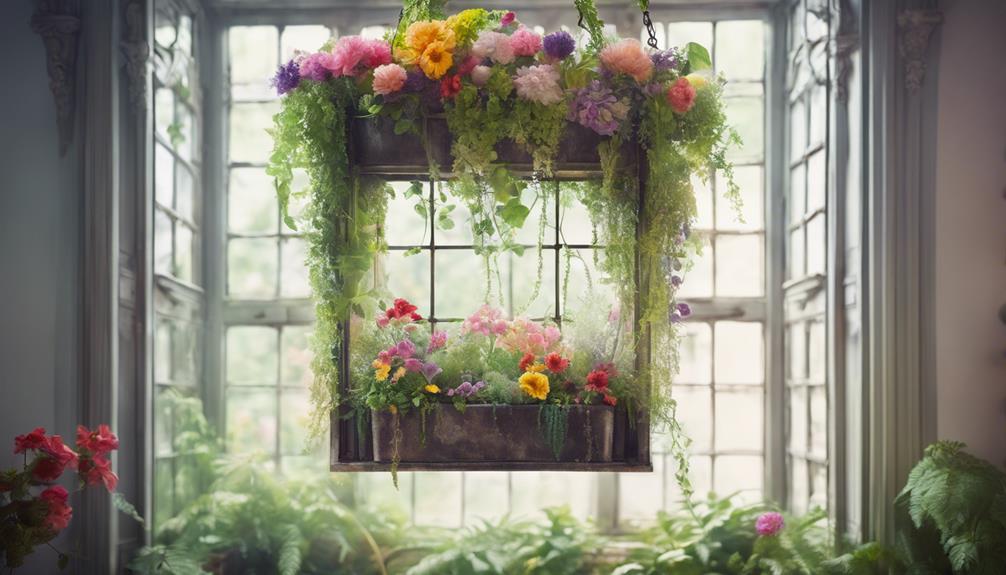
Elegance descends from above with hanging gardens that suspend beauty in mid-air, inviting you to reimagine the ordinary as extraordinary planters. You can create stunning displays that defy gravity and add a touch of whimsy to your outdoor or indoor space.
Here are a few creative ideas to get you started:
- Upcycled Colanders: Fill colanders with coco liner, rocks, soil, and plants, then hang them with twine for a unique planter.
- Hanging Hat Gardens: Transform old baseball hats into flower pot covers by cutting holes for plant stems, adding a touch of quirkiness to your decor.
- Jean Pocket Planters: Upcycle old jeans to display petunias, filling the pockets with unamended dirt or packing peanuts for a charming display.
Sewing Up Some Greenery
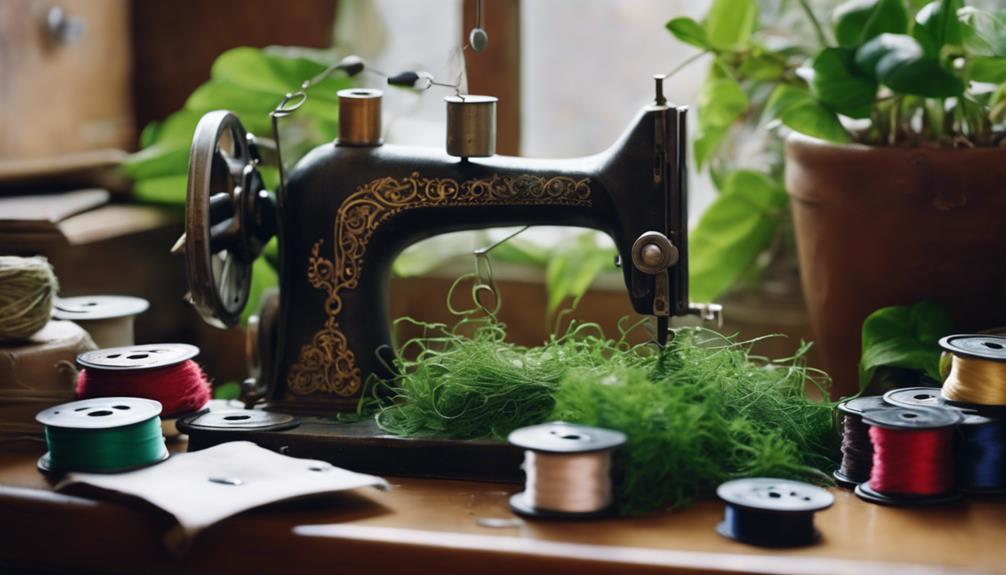
As you've explored the whimsical world of hanging gardens, now turn your attention to upcycling old fabrics, where the humble sewing kit can become a powerful tool for creating unique planters.
One creative way to repurpose old fabrics is by transforming old jeans into hanging planters for petunias. Simply cut the legs of the jeans into desired shapes, sew the bottoms shut, and fill with potting soil and your chosen plants. You can also get creative with embroidery or appliques to add a personal touch to your planter.
This is a great way to give new life to old clothes and reduce waste. By sewing up some greenery, you can create a beautiful and eco-friendly planter that showcases your creativity and love for nature.
Rustic Charm in a Planter
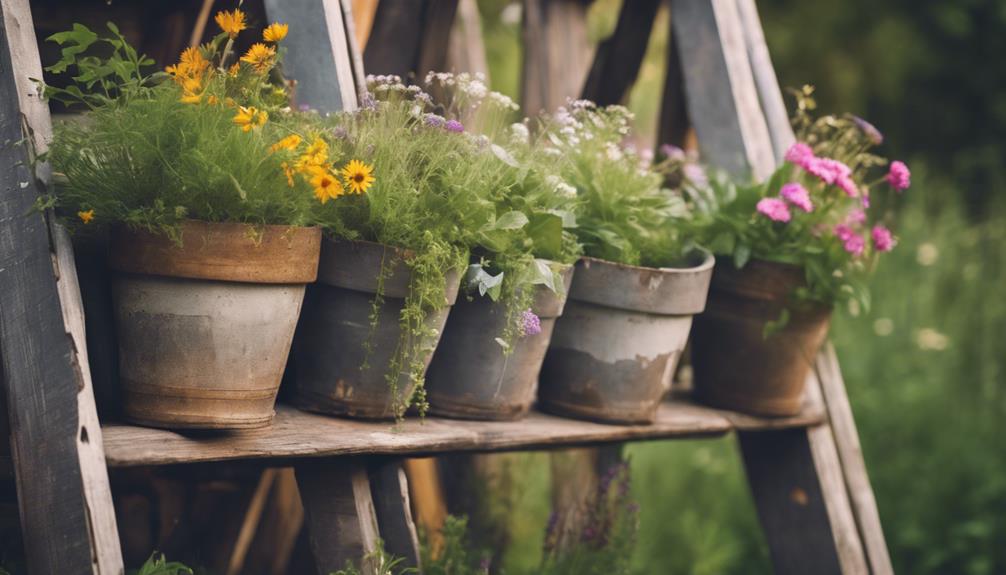
Dig into your storage shed or scour local flea markets to uncover hidden gems that can be repurposed into planters with a dash of rustic charm. These unique containers can add a touch of character to your garden or indoor space. Look for old metal items like toolboxes, tubs, or wheelbarrows that can be transformed into planters.
Here are a few ideas to get you started:
- Vintage wheelbarrows: Fill an old wheelbarrow with flowers, herbs, or succulents for a charming display.
- Distressed wooden crates: Add a touch of rustic charm to your patio or porch with a planter made from an old wooden crate.
- Old metal benches: Upcycle an old metal bench into a planter, perfect for showcasing a small herb garden or a few potted plants.
When choosing your repurposed planter, consider the style and material that fits your garden's aesthetic. With a little creativity, you can turn an old, discarded item into a beautiful planter that adds rustic charm to your outdoor space.
Frequently Asked Questions
How to Repurpose Old Planters?
When you're wondering how to repurpose old planters, start by giving them a thorough cleaning to remove dirt and residue.
Then, get creative! You can paint or decorate them to match your garden decor, turn them into hanging planters or vertical gardens, or use them as storage containers for garden tools.
You can even transform them into unique water features or bird baths. The possibilities are endless, and with a little imagination, you can breathe new life into those old planters.
What Can You Do With Planters Besides Plants?
You might be surprised to know that 75% of households have unused planters lying around. Now, you're wondering what to do with them besides plants. Well, the possibilities are endless!
You can transform them into unique decorative pieces, functional items like candle holders or storage containers, or even outdoor seating. Get creative and think beyond the garden – you can repurpose planters to add a personal touch to your home and outdoor spaces.
How to Upcycle Plant Pots?
When upcycling plant pots, you're not limited to their original purpose. You can transform old items into unique planters.
Look for containers with adequate drainage to guarantee your plants thrive.
Sand, paint, or seal your repurposed planters to safeguard them from the elements and enhance their appeal.
Be cautious of containers that may leach harmful chemicals into the soil.
What Can I Do With Old Plastic Planters?
As you stand amidst the remnants of last season's garden, surrounded by worn-out plastic planters, you wonder what to do with them.
Don't toss them just yet! You can breathe new life into those old planters. You can repurpose them as storage containers, compost bins, or even bird feeders.
Get creative and give them a makeover with a fresh coat of paint or decorations. The possibilities are endless, and with a little imagination, you can turn trash into treasure.
Conclusion
As you've explored these 10 creative ideas for repurposed planters, you've likely envisioned your own garden transformed into a unique oasis. Imagine strolling through your yard, surrounded by vibrant blooms and eclectic planters, each with its own story to tell.
The rusty wheelbarrow, now overflowing with flowers, whispers tales of summers past, while the wine bottle planters sparkle like tiny jewels, reflecting the beauty of creative reuse.
Vivienne – Your Content Companion Vivienne is your content companion, curating valuable tips, advice, and inspiration to guide you on your home decor journey. From insightful blog posts to informative product descriptions, she’s here to empower you with the knowledge you need to create your dream space.
Interior
Does Interior Paint Increase Home Value
Yearning to discover how interior paint can skyrocket your home's value? Get ready to unlock the secrets that will transform your space!
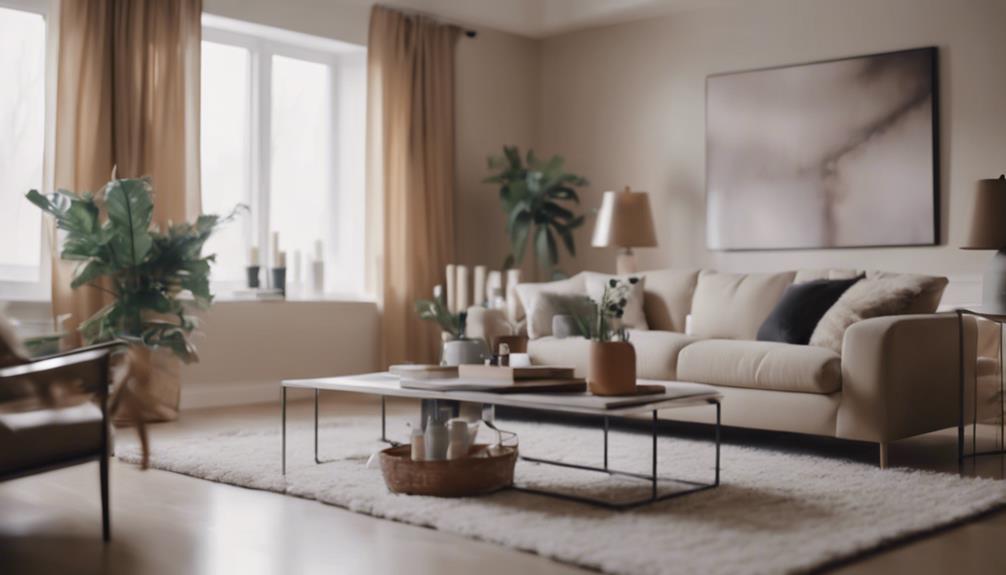
Interior paint plays a crucial role in increasing the value of your home by impressing potential buyers with a cohesive, fresh appearance. The color palettes you select have a long-lasting impact on how your home is perceived, influencing its attractiveness and market value. Choosing high-quality paint and strategic color combinations, such as neutrals, can significantly enhance the value of your property. Additionally, remember to update your interior paint every 7-8 years to maintain that fresh, welcoming atmosphere. Investing in top-notch paint and thoughtful color choices can greatly improve your home’s value and overall visual appeal. Are you ready to enhance the value of your home?
Key Takeaways
- Neutral colors and consistent schemes boost perceived value.
- Quality professional paint jobs command higher prices.
- Regular repainting every 7-8 years enhances home appeal.
- Strategic color choices significantly impact home value.
- Fresh, neutral paint increases space perception and curb appeal.
Importance of Interior Paint in Home Value
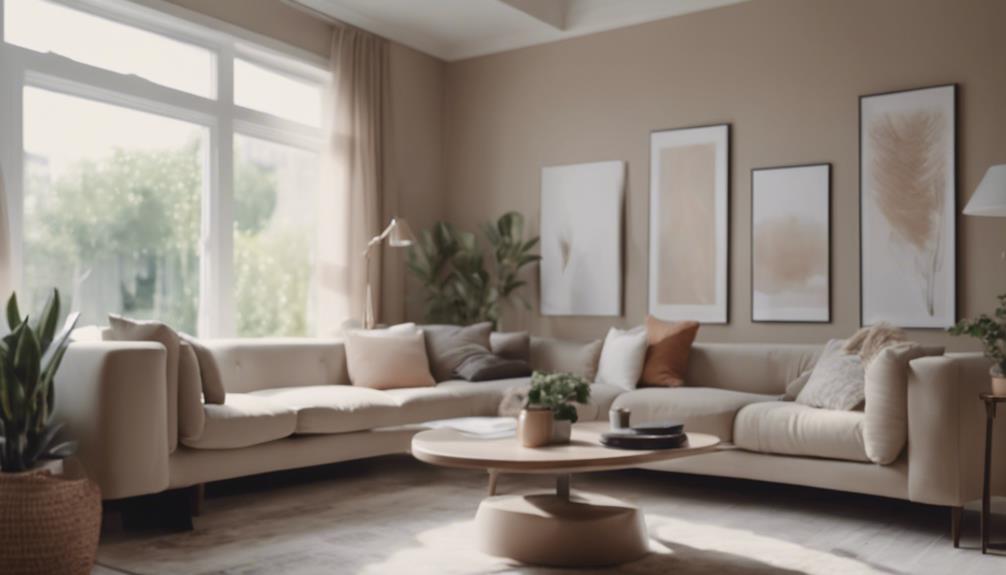
When contemplating the importance of interior paint in determining home value, it's crucial to understand its direct impact on potential buyers' perceptions and the overall financial return on investment.
The colors you choose to paint your walls can greatly influence how buyers view your home. A fresh coat of paint can enhance the perceived value of your home, showing that you have taken good care of the property. Consistent color schemes throughout the house can create a sense of flow and unity, making the space more appealing to potential buyers.
Additionally, repainting every 7-8 years with neutral colors can help maintain a fresh and updated look, maximizing the value of your home. Neutral colors have broad appeal and can make spaces appear larger, which is attractive to buyers. By investing in quality interior paint and choosing the right colors, you can significantly enhance the value of your home and make it more appealing to potential buyers.
Factors Influencing Home Value Through Paint
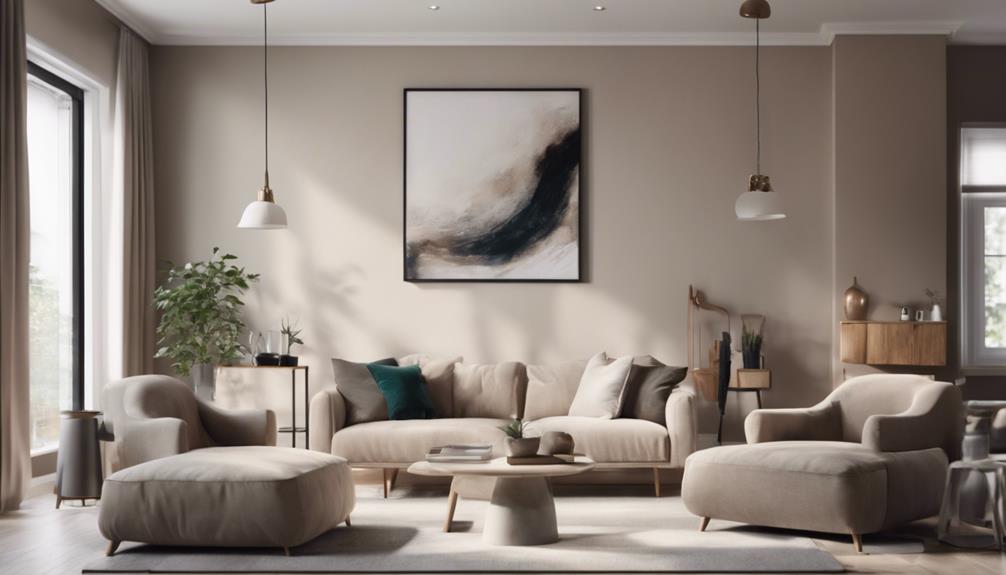
Factors that influence home value through paint include the choice of colors, the quality of the paint job, and the consistency of color schemes throughout the property. Neutral paint colors are highly recommended as they appeal to a broader range of buyers and can positively impact the perceived home value. Opting for professional interior paint jobs not only showcases good maintenance and care but also allows you to command higher prices in the real estate market. Consistent color schemes across your home can greatly improve flow and unity, enhancing the overall appeal and value of the property. Investing in quality interior paint can lead to a remarkable 107% return on investment, making it a wise choice for increasing your home's value. Take a look at the table below for a quick overview of how these factors can impact your home value:
| Factors to Take into Account | Impact on Home Value |
|---|---|
| Neutral Paint Colors | Positive |
| Professional Paint Jobs | Higher Prices |
| Consistent Color Schemes | Enhanced Appeal |
| Quality Interior Paint | Significant ROI |
Choosing the Right Colors for Value
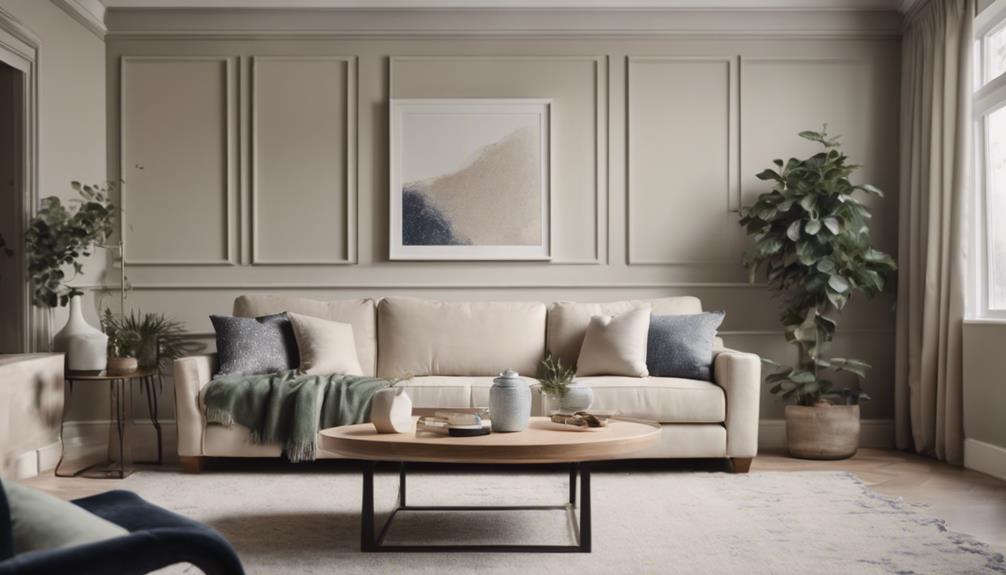
For maximizing your home's value through paint selection, prioritize choosing neutral shades like beige, tan, and greige. When selecting colors for value, keep in mind the impact they can have on your home's overall worth. Specific colors can make a significant difference in boosting your home's curb appeal and perceived value.
Consider the following tips for choosing the right paint colors:
- Darker Colors for Doors: Darker hues like gray, black, or navy blue on doors can add a touch of sophistication and elevate the asking price of your home.
- Light Blue-Gray Kitchens: Opting for light blue-gray tones in kitchens can make your home more appealing to potential buyers and potentially fetch higher selling prices.
- Bold Accent Colors: Using bold accent colors on doors or shutters can create visual interest and enhance the overall value of your property.
- Warm Neutrals: Warm neutrals such as tans and light taupe can help create a welcoming atmosphere and positively impact the perceived value of your home.
Enhancing Home Value With Fresh Paint
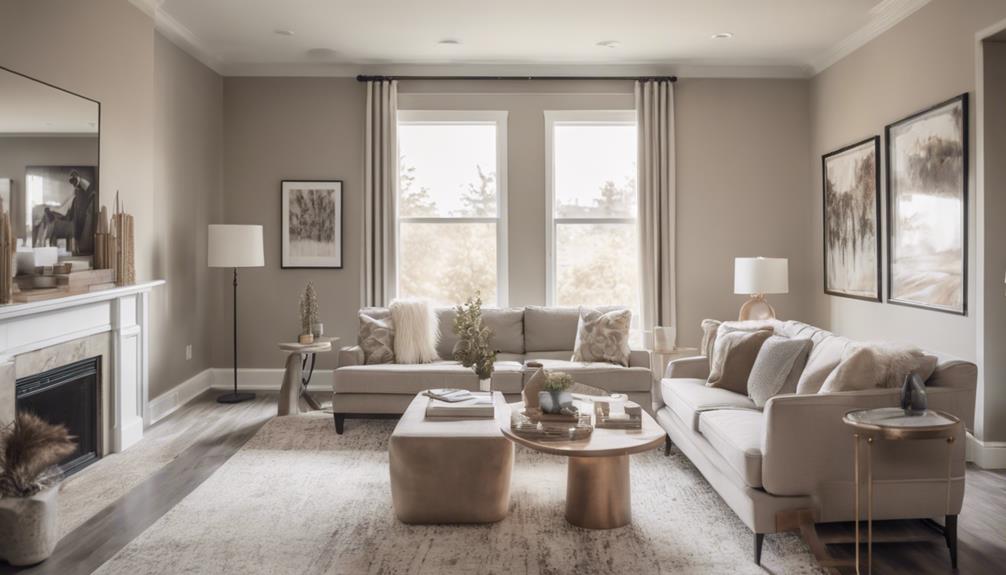
Enhancing your home's value with a fresh coat of paint can be a highly effective and lucrative investment. A fresh interior paint job not only refreshes the look of your home but also has the potential to increase its value substantially.
When potential buyers walk into a home with crisp, freshly painted walls, they immediately see a space that's well-cared for and move-in ready. This first impression can make a big difference in how they perceive the value of the property.
Whether you're painting a single room or giving the exterior a fresh new look, investing in painting as part of your home improvements can pay off in the long run. Fresh, neutral colors can make rooms appear more spacious and inviting, while a well-executed exterior paint job can boost curb appeal and attract more interest from potential buyers.
Maximizing ROI With Interior Paint
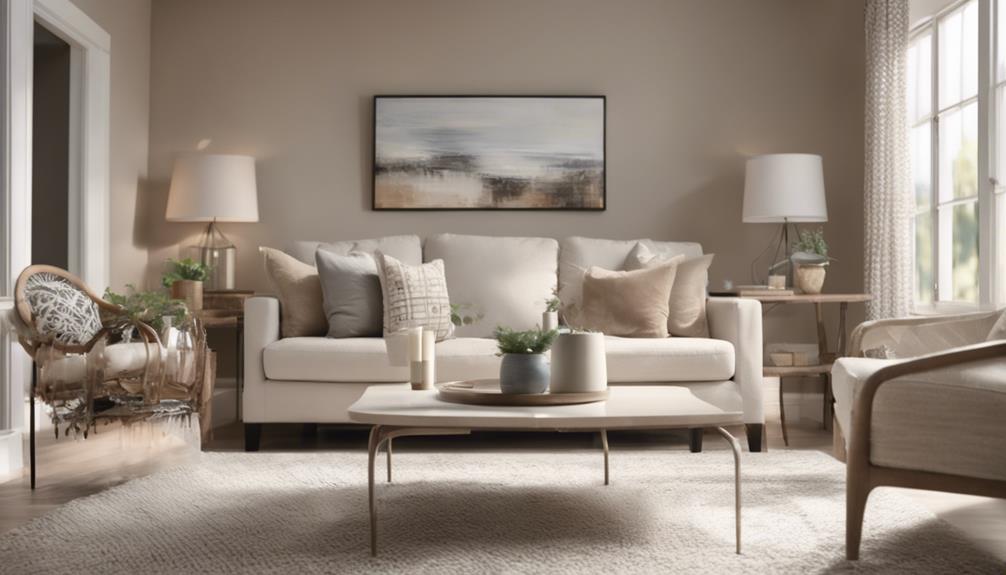
To maximize your return on investment with interior paint, consider the impact of color choices on perceived home value and overall appeal. When aiming to increase your home's ROI through painting, keep these key points in mind:
- Choose Neutral Colors: Opting for neutral tones can elevate the perceived value of your home, appealing to a wider range of potential buyers.
- Regular Maintenance: Repainting every 7-8 years is essential for maintaining your home's value and keeping it looking fresh and well-cared for.
- Consistent Color Schemes: Creating a consistent color palette throughout your house enhances flow and unity, making the space feel cohesive and inviting.
- Maximize Value: By strategically repainting key areas with attention to detail and quality, you can greatly enhance the overall value of your home.
Frequently Asked Questions
What Paint Color Increases Home Value?
Choosing the right paint color can greatly impact your home value. Neutral shades like light gray, beige, and greige are safe bets for increasing attractiveness. Dark colors such as charcoal gray, navy blue, or black on doors can elevate property prices.
Timeless exterior colors boost curb appeal, attracting buyers. Soft blues, greens, and yellows create inviting exteriors. Bold accent colors on doors or shutters add flair and value to your home.
Does Fresh Interior Paint Help Sell a House?
Fresh interior paint can work wonders when selling a house. Did you know that homes with freshly painted interiors tend to sell faster?
That's right! A fresh coat of paint can make your space look newer and more appealing to potential buyers. It's like giving your home a facelift that attracts more attention.
What Is the Best Interior Paint Color for Selling Your Home?
When choosing the best interior paint color to sell your home, go for neutral tones like grays, beiges, or greiges. These colors have broad appeal and can attract a wider range of potential buyers.
Soft blues and greens create a welcoming atmosphere, while bold accent colors on doors or shutters can increase your home's value.
How Much Value Does Paint Add?
Adding a fresh coat of interior paint to your home can greatly impact its value. On average, interior painting can increase your home's worth by $2,112! This high return on investment of 107% makes it a smart choice.
Selecting quality paint and cohesive color schemes can enhance the overall appeal of your home. With the right colors, you can even make your spaces feel larger or cozier, positively influencing your home's value.
Conclusion
So, next time you're thinking about sprucing up your home, remember that a fresh coat of interior paint can truly make a difference in its value.
Some may argue that paint is just a cosmetic change, but in reality, it can greatly enhance the overall appeal and marketability of your home.
Don't underestimate the power of paint when it comes to maximizing your return on investment!
Home Decor
What Is Eclectic Home Decor
Boldly mix styles, colors, and textures in eclectic home decor to create a truly unique and personalized living space.
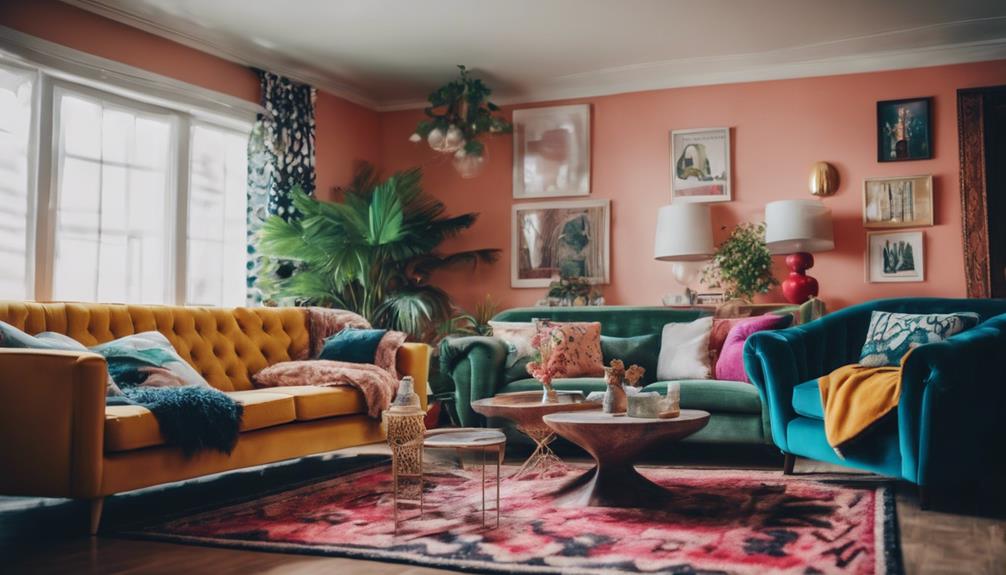
Eclectic home decor combines elements from various styles, periods, and cultures to create a one-of-a-kind living space. This design approach originated in the late 19th to early 20th century, veering away from traditional norms to offer a customized look. Embracing creativity, it melds vintage and modern furniture while incorporating vibrant accent colors for a lively touch. By playing with contrasting pieces and blending textures and colors, you can achieve a visually dynamic and personalized aesthetic that mirrors your uniqueness. Delve deeper into mixing styles, incorporating color and texture, and customizing your space for an authentically eclectic and distinctive home decor experience.
Key Takeaways
- Eclectic home decor mixes different styles, periods, and cultures for a unique look.
- It embraces creativity, individuality, and personal expression in design.
- The style incorporates a diverse range of textures, colors, and patterns.
- Blend vintage and modern furniture for a harmonious space.
- Bold accent colors add energy and personality to eclectic decor.
Origins of Eclectic Decor
Originating as a response to architectural movements rejecting specific styles, eclectic home decor emerged as a design style in the late 19th to early 20th century. This unique style breaks away from traditional design norms by incorporating various elements from different periods, styles, and cultures.
Drawing inspiration from global influences, eclectic decor embraces diversity, mixing patterns, colors, and textures to create a visually stimulating environment. The architectural style that inspired eclectic decor encouraged a blend of old and new elements, providing a platform for individuals to showcase their personality through their home interiors.
The eclectic style is characterized by its unpredictability and variety, allowing for a personalized and expressive design approach. By combining elements from around the world, eclectic decor enables individuals to curate spaces that are both harmonious and diverse, reflecting a thoughtful and purposeful design aesthetic.
Key Elements of Eclectic Design
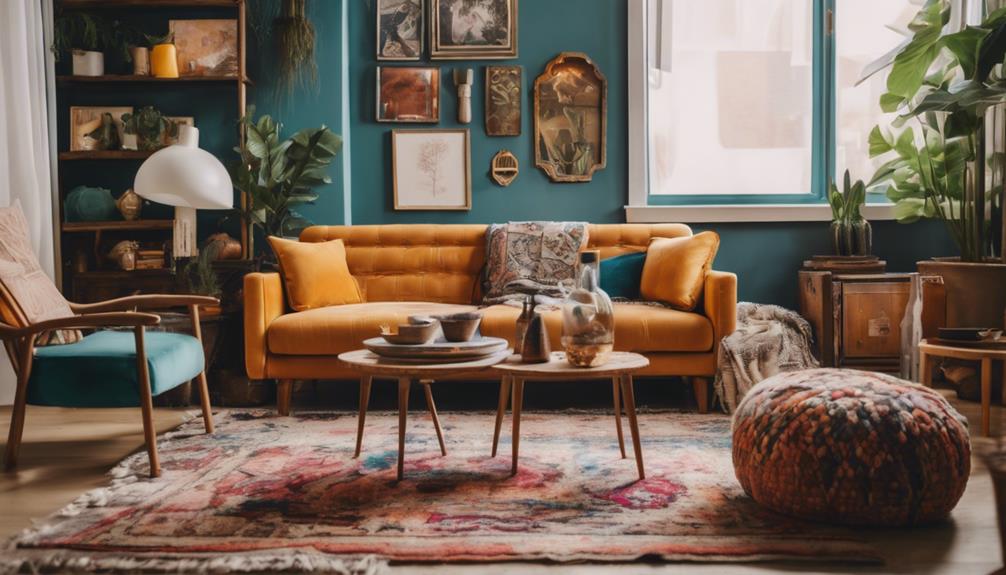
In eclectic design, mixing and matching different styles, periods, and elements is a key element that allows for a unique and visually interesting space. This approach to interior design embraces creativity, individuality, and personal expression.
The eclectic design style thrives on the unexpected, blending old and new pieces seamlessly. A hallmark of eclectic design is the incorporation of a diverse range of textures, colors, and patterns. This mix creates a visually dynamic and vibrant aesthetic within a space.
By combining elements from various design styles, eclectic decor achieves a harmonious fusion that's both visually stimulating and engaging. In eclectic home decor, you can expect to see a blend of vintage and modern furniture, artwork from different eras, and bold accent colors that add energy and personality to the room.
These key elements work together to create an eclectic space that's truly one-of-a-kind.
Mixing Styles in Eclectic Decor
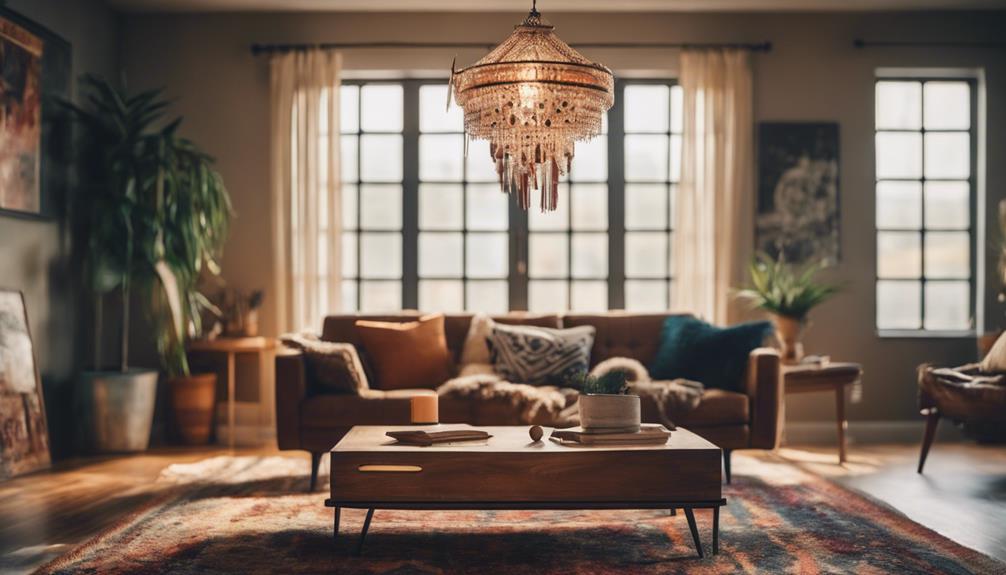
Mixing different styles in eclectic decor creates a visually engaging and personalized look by blending traditional, modern, vintage, and global influences seamlessly. When incorporating various design elements, achieving a balance is crucial to create a cohesive and harmonious space. Here are three key ways to successfully mix styles in eclectic decor:
- Mix and Match: Experiment with contrasting pieces to add depth and interest to your space. Combine a contemporary sofa with antique chairs or mix bold patterns with solid colors to create a dynamic visual impact.
- Blending Traditional and Modern: Blend classic elements like ornate mirrors or vintage rugs with modern furniture to create a unique juxtaposition. This fusion of styles adds character and sophistication to your design.
- Personalized Design Aesthetic: Infuse your personality into the decor by incorporating items that resonate with you. Display cherished mementos, travel souvenirs, or family heirlooms to create a space that reflects your individuality and story.
Incorporating Color and Texture

Let's explore how color and texture play essential roles in creating a visually stimulating and dynamic eclectic home decor.
In eclectic decor, a mix of bold and neutral colors is often used to create a visually stimulating environment. This combination adds depth and interest to the space.
Texture is another vital element in eclectic design, as it involves blending rough and smooth textures to enhance the overall ambiance. By incorporating a variety of textiles such as velvet, silk, and wool, the richness of eclectic spaces is elevated.
Additionally, layering different patterns contributes to the unique and dynamic feel of eclectic decor.
When color and texture are harmoniously integrated into eclectic home decor, they work together to create a personalized space with a diverse aesthetic. This blending of elements helps in achieving a cohesive and visually appealing look that's both inviting and intriguing.
Personalizing Your Eclectic Space
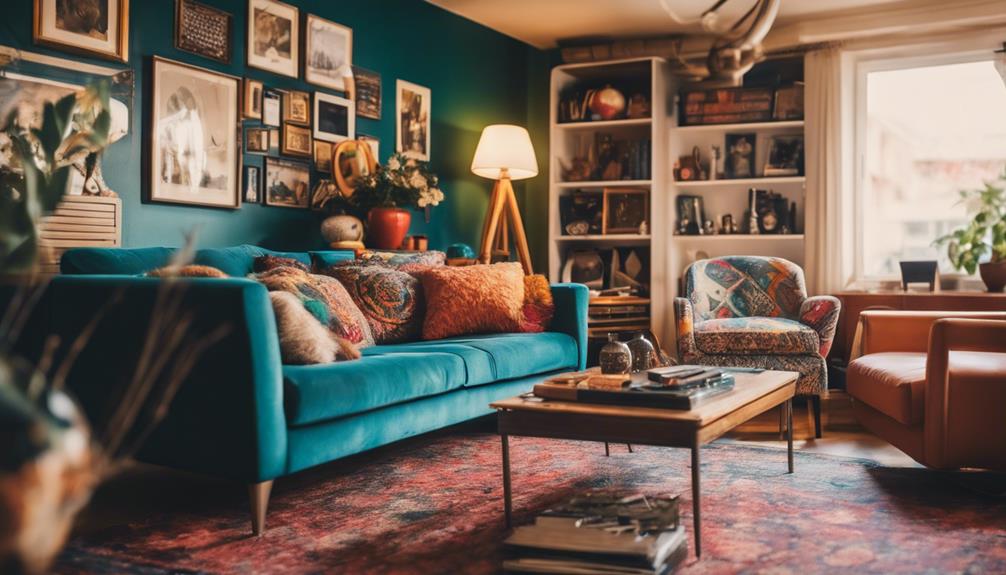
When personalizing your eclectic space, we can create a unique blend of decor that reflects our individual style and interests.
By experimenting with a mix of textures, patterns, and colors, we can craft a visually engaging environment that speaks to our personality.
Showcasing our personal flair through curated art, decor, and meaningful mementos can infuse our eclectic space with character and authenticity.
Unique Decor Combinations
Creating a space that reflects your unique personality through a blend of diverse decor elements is the essence of personalizing an eclectic home. When combining vintage and modern pieces with diverse patterns, consider the following:
- Mixing Textures: Incorporate a variety of textures like plush rugs, smooth metals, and rough wood to add depth and visual interest to your space.
- Playing with Colors: Experiment with bold color combinations or stick to a neutral palette while adding pops of color through accent pieces for a vibrant look.
- Balancing Scale: Mix large statement pieces with smaller items to create a visually balanced composition that draws the eye around the room.
Showcasing Personal Style
To truly showcase our personal style in an eclectic space, we infuse it with elements that resonate with our individuality and story. Personalizing our eclectic home decor involves incorporating personal mementos, travel souvenirs, and favorite items to add a unique touch.
By displaying items that hold sentimental value, we create a sense of nostalgia and connection within our space. Mixing and matching elements that reflect our tastes and interests allows us to craft a truly personalized eclectic home decor.
Ensuring that we infuse our space with pieces that speak to us guarantees that our eclectic decor reflects who we're and the journey we've been on. Embracing these personalized touches helps make our home a true reflection of our eclectic and personal style.
Tips for Achieving Eclectic Style
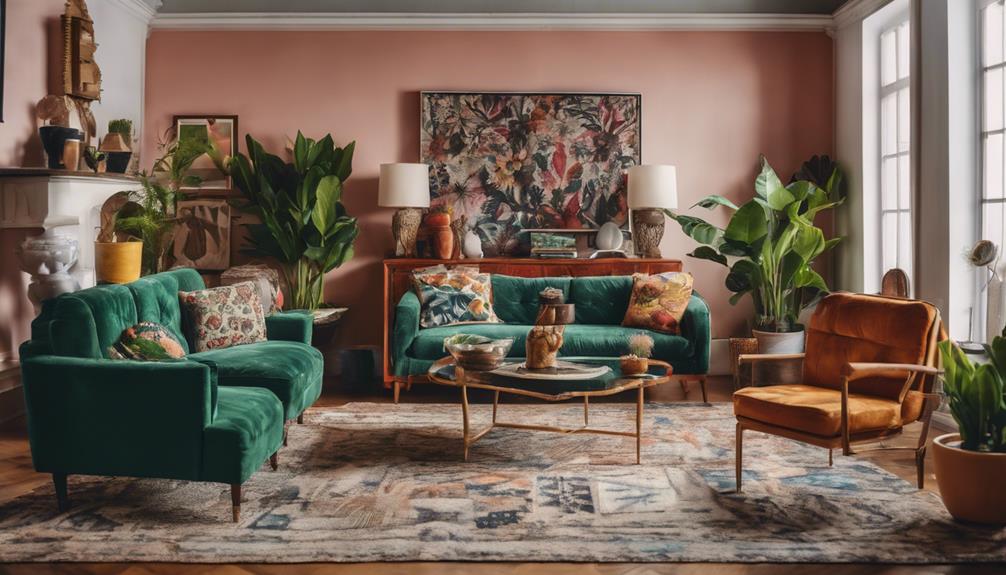
For achieving an eclectic style, starting with a neutral base sets a versatile foundation for your decor. This allows you to easily incorporate a mix of colors, patterns, and textures without overwhelming the space. Here are three key tips for achieving an eclectic style:
- Mix Furniture Styles: Blend different furniture styles in varying proportions to create a dynamic and personalized look. Pair modern pieces with vintage finds or mix sleek lines with intricate details to add visual interest.
- Layer Textiles: Utilize rugs, throws, and pillows to add layers of texture to your space. Mixing different fabrics, patterns, and colors can enhance the cozy and inviting feel of an eclectic room.
- Showcase Personal Collections: Display your personal collections and artwork to infuse your space with individuality and character. Whether it's vintage vinyl records, travel souvenirs, or family heirlooms, incorporating these elements can make your eclectic decor truly unique.
Frequently Asked Questions
How to Make Your House Look Eclectic?
To make your house look eclectic, we blend various furniture styles like vintage and modern pieces. We mix materials such as velvet and silk for textures and display a diverse art collection with personal mementos.
Experiment with different lighting sources to create ambiance and add finishing touches like plants and rugs. By combining these elements, we can achieve a unique and visually interesting eclectic home decor style.
What Does Eclectic Mean House?
Eclectic in a house means blending diverse styles, periods, and origins for a unique look. It involves mixing textures, colors, and materials creatively.
This style allows for showcasing individuality and diverse tastes through unexpected decor combinations. Mixing old and new elements purposefully creates a visually interesting space.
The approach is all about embracing variety and personal expression in design.
What Is the Difference Between Eclectic and Bohemian Decor?
Eclectic decor mixes various styles, periods, and textures for a personalized look.
Bohemian decor, on the other hand, leans towards a relaxed, globally inspired aesthetic.
Eclectic intentionally blends diverse design elements, while bohemian has a more organic and spontaneous vibe.
Bohemian often features natural materials and earthy tones with eclectic patterns, while eclectic embraces a broader range of design influences.
Both styles value individuality and creativity but showcase distinct visual expressions in home decor.
What Are Eclectic Ideas?
Eclectic ideas in home decor involve combining diverse styles, periods, and cultures to create a unique and visually alluring space. By blending old and new elements, unexpected decor touches, and purposeful design choices, eclectic decor allows for a mix of furniture, accessories, colors, and patterns that reflect individuality and creativity.
How can we infuse our living spaces with a sense of personality and character through eclectic design choices?
Conclusion
To sum up, eclectic home decor is a versatile and creative design style that allows for the mixing of different elements and styles to create a unique and personalized space.
Did you know that 85% of interior designers believe that incorporating eclectic decor can add personality and character to a room?
By following the key elements and tips for achieving eclectic style, you can create a visually interesting and inviting home that truly reflects your personality and taste.
Wall Art and Decor
How Long to Paint Interior of New House
Delve into the process of painting a new house to discover how different factors impact the duration and quality of the project.
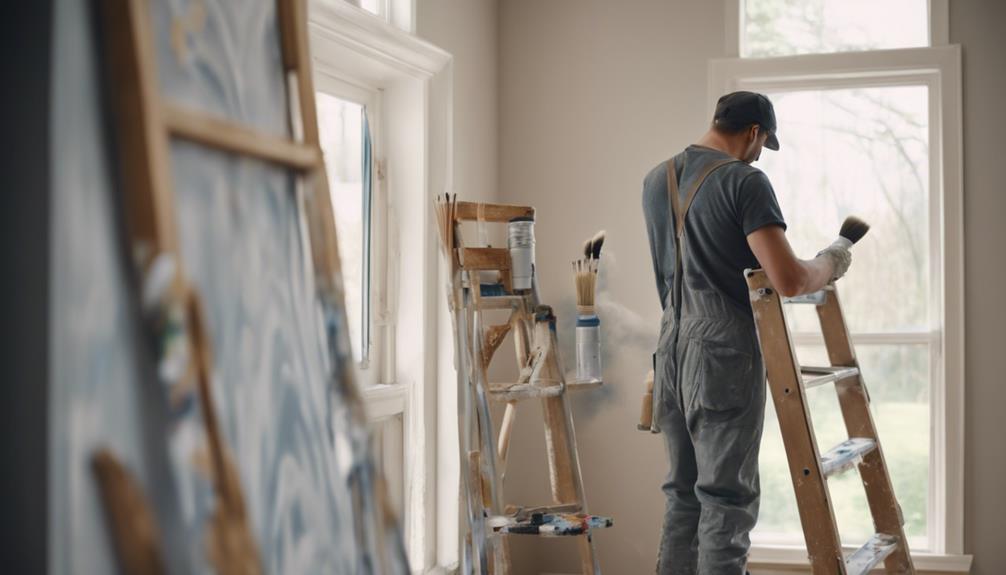
To complete the painting of the interior of a new home, it typically takes around 3.5 weeks. This timeframe accounts for addressing any imperfections resulting from fresh construction, as well as the necessary time for preparation and painting. Variables such as the home’s size, materials used, and quality of workmanship can impact how long the process takes. Enlisting the help of professionals can speed up the project and ensure a top-notch outcome. Thorough preparation work is crucial for achieving a flawless final result. If you’re interested in learning more about efficiently painting a new home, continue exploring the factors that influence painting duration and preparation to gain a comprehensive understanding.
Key Takeaways
- Consult professionals for accurate time estimates.
- Size, intricacy, and surfaces affect painting time.
- Prep work like cleaning, sanding, and taping is crucial.
- New builds with imperfections require extra preparation.
- Efficient techniques streamline the painting process.
Factors Affecting Painting Time

When pondering the time needed to paint the interior of a new house, various factors greatly influence the painting duration. Professional painters typically estimate around 3.5 weeks to complete the painting of an entire new house, especially when meticulous work is required for a fresh build.
New construction often comes with imperfections that demand additional prep work, impacting the overall painting timeline. Factors such as different materials used, higher ceilings, and the level of quality workmanship can also impact the time needed to paint a new house.
It's important to consult with multiple painters to get accurate time estimates and to take into account potential unexpected delays or touch-ups that may be needed for a precise completion timeline. By being aware of these factors and planning accordingly, you can ensure a smoother and more efficient painting process for your new home.
Size of the House
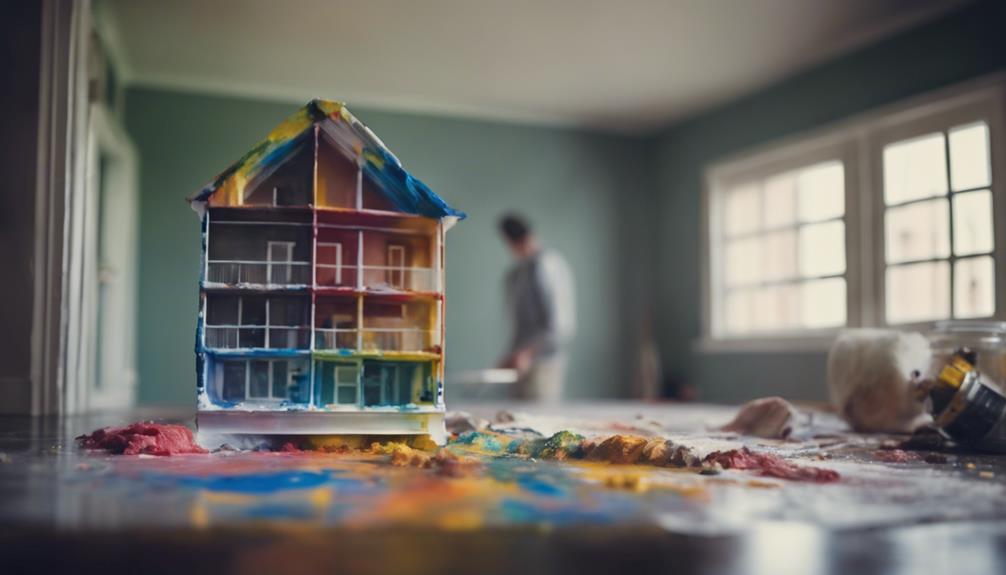
When considering the time needed to paint the interior of your new 2900 square foot house, the size of the house plays an important role. The larger the square footage and the more rooms you have, the more time-consuming the painting process will be.
Factors such as the number of walls and ceilings to paint will contribute to the overall timeline for completing the project.
House Square Footage
Considering the size of the house at 2900 square feet, the painting process will require careful planning and efficient execution. The square footage of the house, along with the 10-foot ceilings downstairs and 9-foot ceilings upstairs, will impact the time needed for painting.
The presence of a few built-ins means extra care will be needed around those areas. Luckily, the kitchen cabinets don't require painting, which can save time during the painting process.
The specifics of this new build play an important role in determining the overall painting time. With a house of this size and these features, it's essential to factor in all these details when planning the interior paint job.
Number of Rooms
To efficiently paint the interior of a new house, the number of rooms plays a crucial role in determining the overall time required for the job. A house with fewer rooms will generally take less time to paint compared to a house with a higher number of rooms.
For instance, a small house with only a few rooms might take around 24 days to complete the painting process. On the other hand, a larger house with multiple rooms, especially those with 3 stories and 5+ bedrooms, could extend the painting duration to approximately 57 days.
The size of the house, considering the number of rooms, significantly impacts the timeline for completing the paint job in both new construction and renovation projects.
DIY Vs Professional Painting
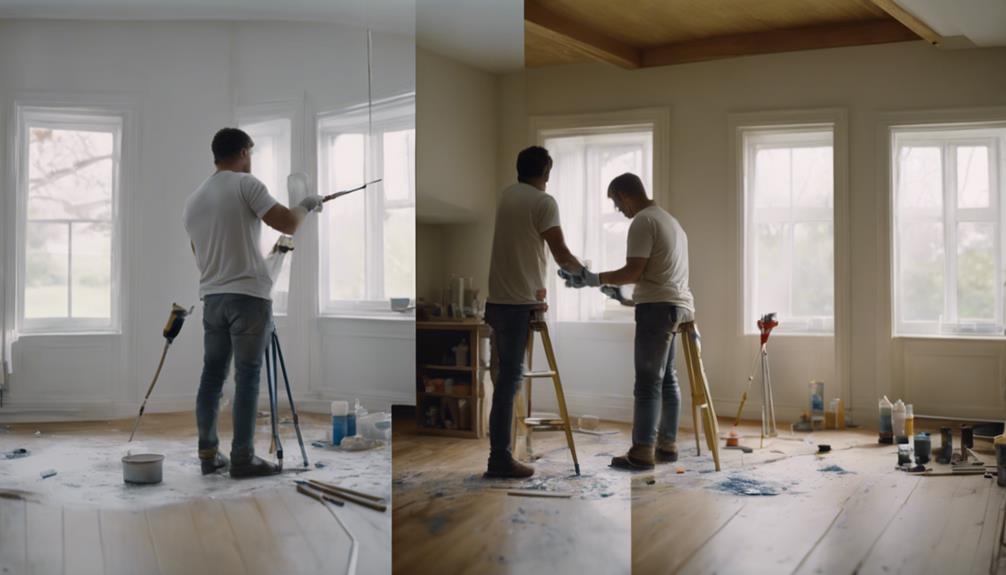
For the best results in painting the interior of your new house, considering the benefits of DIY painting versus hiring professionals is crucial. Here are a few key points to help you make an informed decision:
- Hiring a professional painter can greatly reduce the time required to complete the interior paint job.
- DIY painting projects often take longer due to the lack of experience and efficiency of individuals.
- Professional painters are skilled in delivering superior quality results compared to DIY efforts.
- Enlisting professional help guarantees that the painting process is done effectively and efficiently, saving you time and effort.
When it comes to achieving a flawless finish and efficient completion of your new house's interior paint job, entrusting the task to a professional painter can make a significant difference. Their expertise in prep work, painting techniques, and cleanup not only saves you time but also ensures a high-quality outcome for your home.
Prep Work Importance
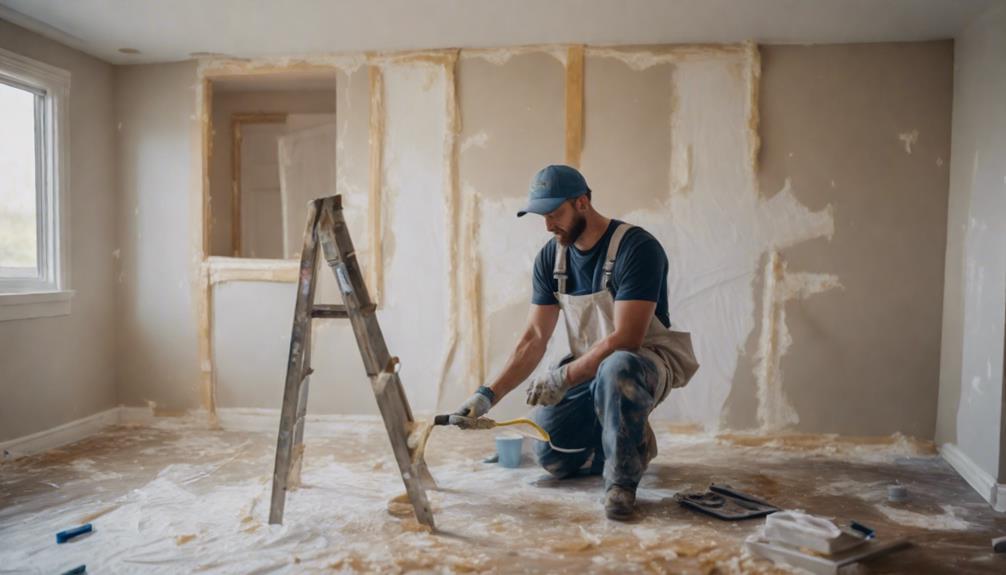
Investing time in proper prep work before painting your new house is essential for achieving a flawless and long-lasting finish. Prepping involves tasks like wall repairs, sanding, and taping. Taping alone can take around 40 minutes per room but guarantees clean edges for a professional look. The effort put into prep work directly impacts the quality of the final paint job. It helps in achieving a high-quality finish that lasts longer without needing frequent touch-ups. In addition, effective prep work not only enhances the aesthetic appeal but also saves time during the actual painting process. By addressing imperfections beforehand, you streamline the painting process and reduce the chances of interruptions or rework. Prioritizing prep work in the beginning can make the overall painting experience smoother and more rewarding.
| Task | Importance | Time Required |
|---|---|---|
| Wall Repairs | Essential | Varies |
| Sanding | Enhances Finish | 20-30 mins |
| Taping | Clean Edges | 40 mins/room |
Painting Process Overview

When painting the interior of a new house, it's essential to understand the key points:
Prep Work Importance,
Time Estimation Factors, and
Efficient Painting Techniques.
These elements will help you navigate the process efficiently and achieve a satisfactory result.
Prep Work Importance
Proper preparation, such as cleaning, sanding, and taping, is essential for ensuring a smooth painting process when tackling the interior of a new house. To emphasize the importance of prep work, consider the following:
- Taping alone can add around 40 minutes per room to the overall painting time.
- Ensuring thorough prep work helps in achieving a high-quality finish.
- Professional painters are efficient in prepping the surfaces before painting.
- The time spent on prep work directly impacts the overall duration of painting the interior of a new house.
Time Estimation Factors
To accurately estimate the time required for painting the interior of a new house, consider various factors such as the size, intricacy, and surfaces involved in the painting process. A professional painter estimated 3.5 weeks to complete painting in a new house, accounting for the size and details of the build.
New construction projects often demand meticulous work due to imperfections that require extra prep time. Factors like different materials, surfaces, and higher ceilings can influence the time needed for painting a new house. Quality workmanship in new constructions may necessitate additional time to guarantee a precise finish.
It's advisable to consult multiple painters for time estimates and insights on the specific challenges that painting new constructions may present.
Efficient Painting Techniques
Implementing efficient painting techniques can greatly streamline the process of painting the interior of a new house. To guarantee a smooth painting process, start by properly cleaning and prepping the walls. Remember to remove furniture, tape edges, and cover floors.
Next, focus on filling holes, sanding surfaces, and priming walls if necessary. When applying coats of paint, allow for drying time between each coat. Utilizing rollers for larger areas can speed up the painting process.
Time Estimate for Cleaning
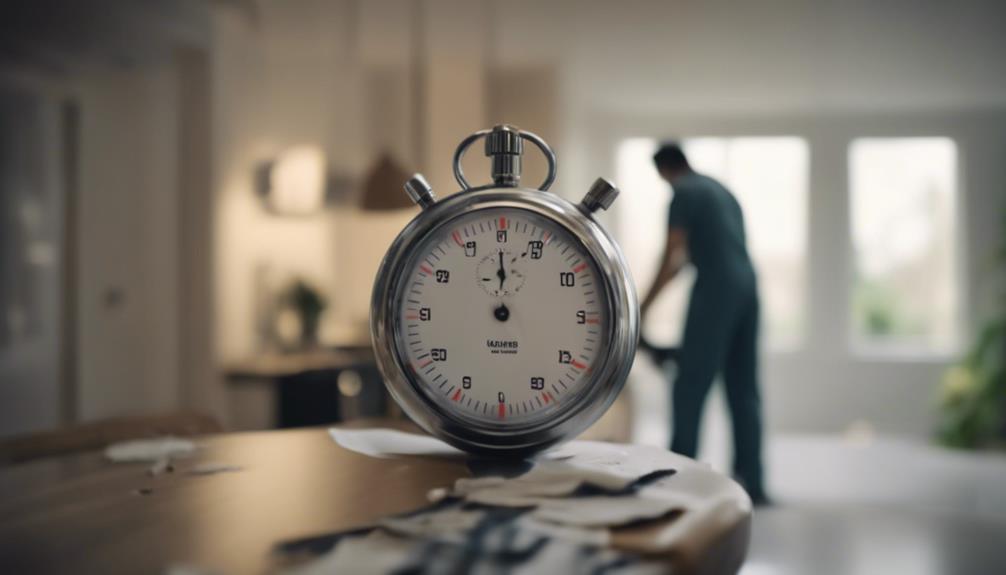
Before you begin painting the interior of your new house, allocating 1-2 days for thorough cleaning is essential. Cleaning plays an important role in ensuring proper paint adhesion to surfaces. Removing dust, grease, and mildew is key for a successful foundation.
By thoroughly cleaning walls, ceilings, and trim, you pave the way for a smooth and even paint application. This process typically involves wiping down surfaces, vacuuming, and using mild cleaning solutions. Taking the time to clean your new house properly sets the stage for a long-lasting paint job.
Time Estimate for Preparation
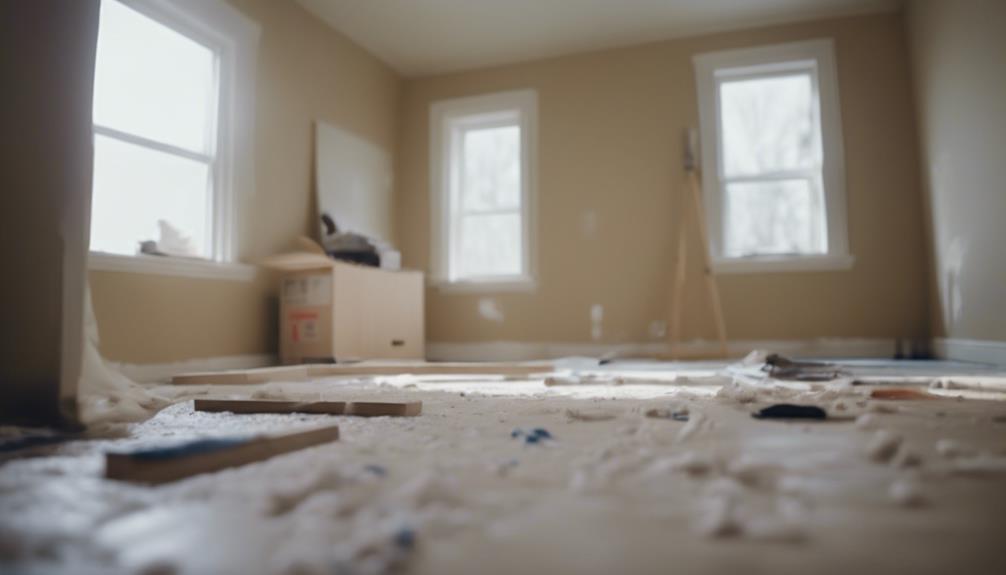
Estimating the time needed for preparation before painting the interior of your new house is essential for a successful and efficient project. To guarantee a smooth painting process, consider the following key tasks when estimating your preparation time:
- Cleaning Walls: Spending 1-2 hours cleaning and prepping walls is vital for paint adhesion.
- Removing Furniture: Factor in extra time for moving furniture and fixtures out of the rooms being painted.
- Taping Edges: Allocate time for taping edges and covering floors to protect areas not meant for painting.
- Filling Holes and Sanding Surfaces: Thoroughly fill any holes and sand surfaces for a flawless paint finish.
Time Estimate for Painting
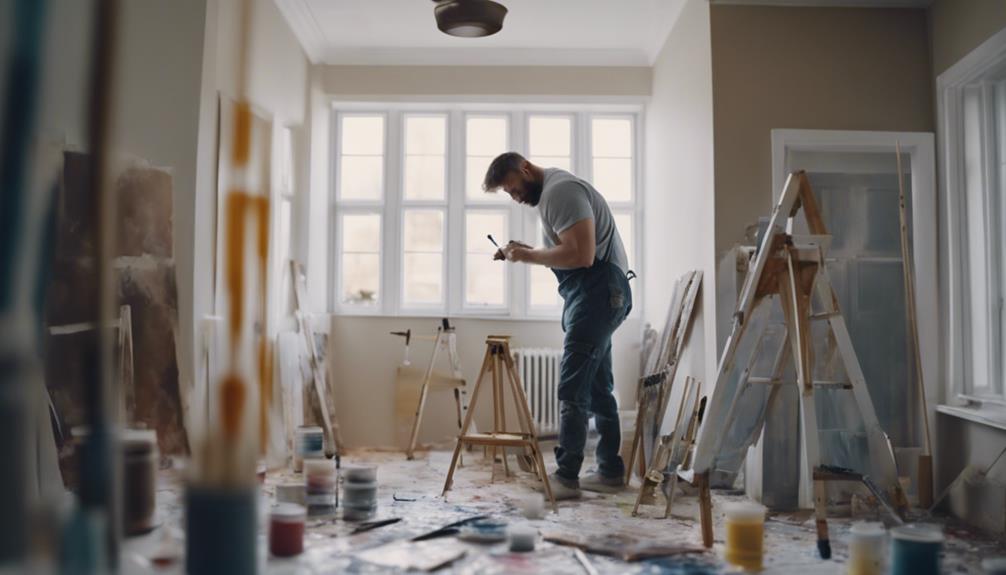
When planning the painting timeline for your new house, consider the intricate details and size of the project to guarantee a thorough estimate. Professional painters typically estimate around 3.5 weeks to paint an entire new house, factoring in the specific challenges of new construction.
New builds often require more prep work due to imperfections and different materials, impacting the overall painting time. Factors like higher ceilings and the need for quality workmanship can further extend the duration needed for painting.
It's advisable to consult with multiple painters to get accurate time estimates, considering the intricacies of your project and desired quality levels. Additionally, unexpected delays are common in new build painting projects, necessitating extra time for touch-ups and meticulous work to ensure a high-quality finish.
Be prepared for these potential delays when planning your painting timeline for the new house.
Time Estimate for Cleanup

For an efficient and polished painting project, consider the time estimate for cleanup after painting the interior of a new house. Cleaning up after interior painting in a new house typically takes around 1-2 hours. To guarantee a spotless finish, tasks involve removing drop cloths, picking up tools, and properly disposing of paint cans. Professional painters excel at thorough cleanup, leaving the space in pristine condition.
DIY cleanup, on the other hand, may require dusting surfaces, organizing tools, and responsibly getting rid of paint supplies. Remember, effective cleanup plays an important role in the overall success and appearance of the painting project.
- Removing drop cloths
- Picking up tools
- Disposing of paint cans
- Ensuring a spotless finish
Frequently Asked Questions
How Long Does It Take to Paint the Inside of a New House?
To paint the inside of a new house, it typically takes about a week. This includes prep work, priming, and painting. New constructions may need extra attention due to surface imperfections. Factors like absorbent drywall or high ceilings can affect the time needed.
Consider additional time for intricate details or multiple coats. Be prepared for meticulous work, especially in new builds, to guarantee a quality paint job.
How Long Does It Take to Paint a 1500 Sq Ft House Interior?
Painting a 1500 sq ft house interior typically takes around 36 days. Factors like furniture moving, paint crew size, repairs, and prep work impact the timeline.
Cleaning, preparing, painting, and cleanup all contribute to the overall duration. The number of rooms, paint colors, coats needed, and trim painting affect the time it takes.
Hiring professional painters for efficiency and quality results is recommended.
How Many Man Hours Does It Take to Paint the Interior of a House?
To paint the interior of a house, the number of man hours required depends on factors like the size of the house, the complexity of the job, and the number of painters working. Proper planning and organization are key to maximizing efficiency.
Typically, a team of professional painters can tackle the job in a timely manner, ensuring quality results. Communication and teamwork among the crew play an essential role in completing the project within the estimated time frame.
Can You Paint a Whole House in One Day?
You can typically not paint a whole house in one day. Factors like size, complexity, and prep work make it challenging. Rushing can lead to poor quality.
Professional painters might do smaller houses in a day, but larger ones need more time. Plan for the appropriate amount of time to guarantee a thorough paint job.
Conclusion
To wrap up, painting the interior of a new house can take anywhere from a few days to a couple of weeks, depending on the size of the house, whether you choose to DIY or hire professionals, the importance of prep work, and the overall painting process.
It's important to allocate enough time for cleaning, preparation, painting, and cleanup to guarantee a successful and efficient painting project. Plan accordingly and you'll have a freshly painted home in no time!
Mason – Your Product Expert Mason is your go-to product expert, carefully selecting each item in our collection to ensure it meets your comfort, functionality, and style needs. With his attention to detail and commitment to quality, he ensures that every product we offer enhances your home experience.
-

 Vetted8 months ago
Vetted8 months ago15 Best EMS Foot Massagers for Neuropathy to Soothe Your Feet
-

 Vetted7 months ago
Vetted7 months ago14 Best Personalized Father's Day Gifts for Your Husband – Show Him You Care
-

 Alfresco7 months ago
Alfresco7 months agoAlfresco Stacker Doors: Seamless Indoor-Outdoor Living!
-

 Tableware and Dining Accessories2 weeks ago
Tableware and Dining Accessories2 weeks agoWhat Is the Meaning of the Word Tableware
-
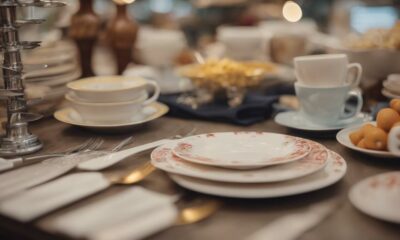
 Tableware and Dining Accessories2 weeks ago
Tableware and Dining Accessories2 weeks agoWhen Is Tableware on Sale at Hobby Lobby
-
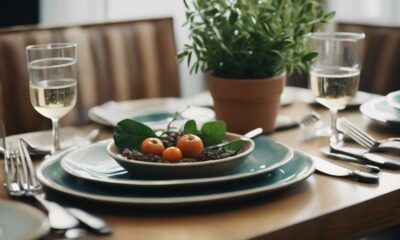
 Tableware and Dining Accessories2 weeks ago
Tableware and Dining Accessories2 weeks agoWhich of the Following Is Not Classified as Tableware
-

 Vetted8 months ago
Vetted8 months ago15 Best Detergents for Wool: Keep Your Woolens Looking Fresh and Fabulous
-

 Craft and Textiles8 months ago
Craft and Textiles8 months ago15 Best Places to Buy Appliances for Your Home – Top Retailers Reviewed































